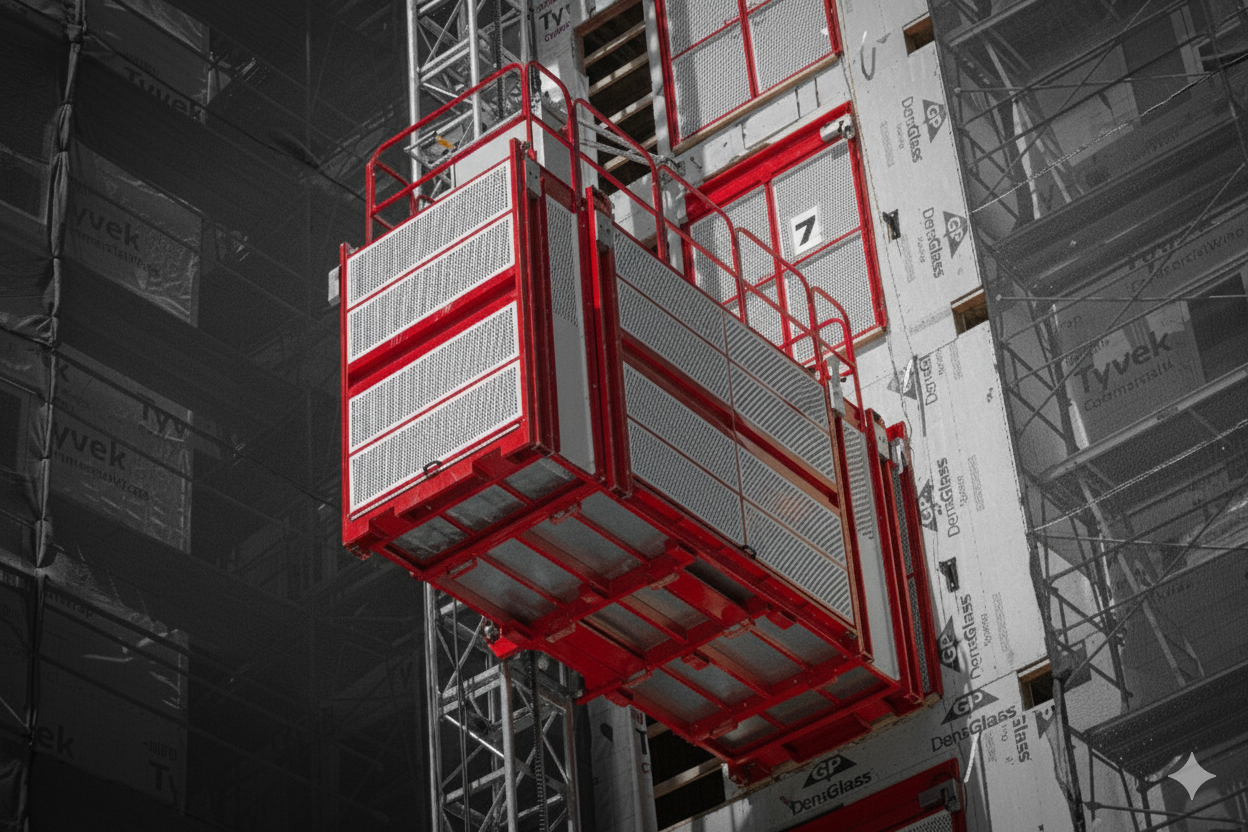Automated Transport Platform by Elevek. 4400 lbs of lifting capacity. 10’ long. No operator required. Call to floor functionality. is a feature in these construction elevators
Automated Hoists
Construction Hoist rated at 7000 lbs available for sales in North America
Construction Hoist
Construction Hoists are a reliable means to lift and lower heavy materials or equipment on construction job sites. It provides a dependable vertical lifting solution, reducing manual labor and improving efficiency on-site. Their safe operations is of the utmost importance. The right hoist will minimize downtime and ensure safe operation. Construction hoists are commonly used in mid rise and high rise construction building projects, renovations, and other tasks that involve moving loads to higher work areas. Lifting Capacity is commonly 7000 lbs. Our lifting speeds are commonly 197’ per minute. Lifting Heights will be listed as limited to 660’. If you need to go taller we just have to plan with the right based towers.
Types of Construction Hoists
There are several types of construction hoists available, each designed to meet specific needs, requirements and industry standards. Some of the most common types of construction hoists include:
Personnel Hoists: Designed for vertical transportation of personnel, these hoists are ideal for emergency evacuations and situations where personnel require quick and easy access to the job site.
Material Hoists: These hoists are designed for transporting materials and equipment, and are widely used in construction projects.
Transport Platforms: Programed for passengers, or just materials. up to 4400 lbs and 10’ in length. We can go to 13’ with larger towers. The Safety Features and the designs of these are compliant with ANSI A92 making them officially a Scaffold system. This can have the ability to get around hoist licensing requirements in some states.
Own the Hoist
Rental of Hoists has contractors paying for the entire hoist just about each job. Contractors suited to maintain a fleet of machines could collect the rents they would pay from one or two jobs and find that they no longer have to transfer that money to a sub contractor. In many cases, you can re build the hoist motors and panel after 15 years and just replace the car. The towers and bases can continue to be used. The effect is that in the second evolution, you don’t even pay half of the cost and you feel like you have a brand new hoist without the $10,000 a month rental cost. You can just keep that money.
Personalize it and Advertise
Sell your next job with your current job. Hoists are highly visible. You can have your name and logo on the hoist. Show all of your prospective clients what you do.
New Technology
Our transport platforms are up to date. They can communicate with the factory. If you have an issue developing, we might know before you. Or if one has developed, we can either find a work around, or get parts moving without delay. The control systems are from Schneider. Motors and gearboxes are from SEW Eurodrive. Both places have representation and warehousing in the US. And with the automation we offer, you can have a materials hoist without any one running the hoist. Operators? Nope. Either call it to you from the floor, or send it to the floor where you need it. It couldn’t be easier.
Free Standing to 131’
If you are building 5 over 2 buildings made of wood, would you like to avoid the added engineering, blocking and straps required to attach construction hoists to your building? We have a triple tower design that makes it so you can stand the hoist like a tower crane. No tie ins to 131’. That 80’ building can simply involve assembling towers. You spend more for the triple tower system. But if you are doing the same types of buildings over and over that can benefit from this, you save the added engineering and work on every job. Within a couple of jobs you’ll have paid for the system and never need to tie in again.
Safety and Maintenance
Safety and maintenance are crucial when it comes to construction hoists. It is essential to follow the manufacturer’s instructions carefully and ensure that the hoist is properly maintained and serviced. Regular maintenance and inspections should be conducted to assess all aspects of the hoist, including the condition of the chains, hooks, and brakes. Any signs of wear and tear should be addressed promptly, and potential hazards that could cause an accident should be identified and mitigated to ensure reliability.
Take Control of Inflation
If it’s time for your company to control your costs, we can help with the purchase of hoists. Let’s talk about your needs and find you a fixed cost for the next decade to 15 years. Once you have a process in place to have the hoist erected, maintenance and compliance can be handled efficiently. Reach out at sales@cranegear.net. I’ve owned some of these hoists myself. They are a great solution and the performance and features are great. If you want the advantage over the competition and the tax write offs of owning piece of equipment, I hoist is a good way to go.

7000 lbs and up to 17’ long.
If you need a Construction Hoist that matches ANSI A10.4, has automated gates, SEW Eurodrive motors and gearboxes with Schneider controls as set up to be UL Compliant, we can help.
Reach out at Sales@cranegear.net for assistance.

